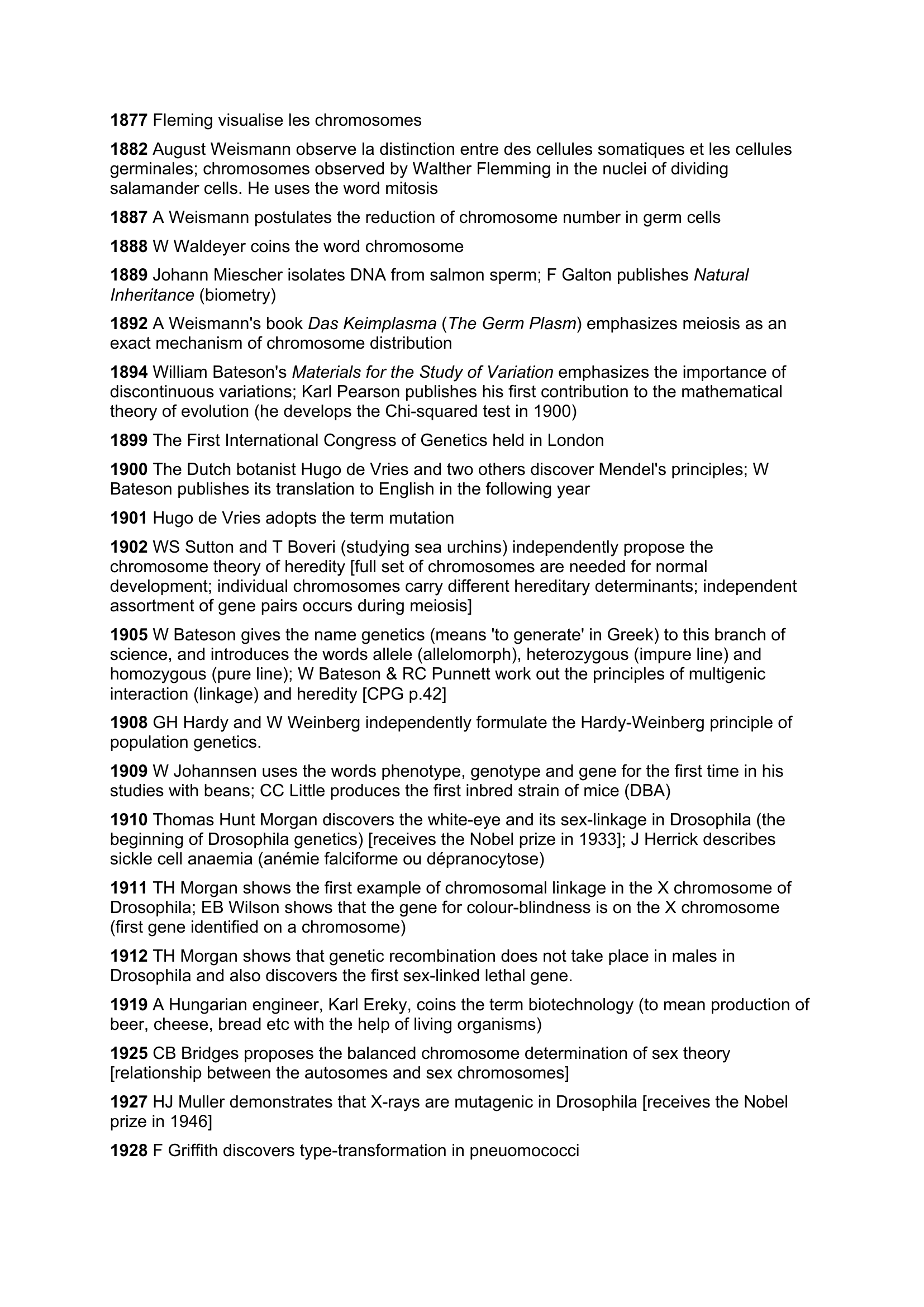Les principales dates de l'Histoire de la Génétique
Publié le 02/04/2019

Extrait du document

1965 S Brenner et al discovers the stop codons; RW Holley works out the first complete nucleotide sequence of a tRNA (yeast alanine tRNA) [receives the Nobel prize in 1968 together with Nirenberg and Khorana]
1966 B Weiss & CC Richardson discover DNA ligase; VA McKusick publishes Mendelian Inheritance in Man which is available online.
1967 CB Jacobson & RH Barter use amniocentesis for prenatal diagnosis of a genetic disorder; MC Weiss & H Green works out the autosomal chromosomal assignment of a human gene for the first time [thymidine kinase gene]; HG Khorana et al establishes the genetic code [receives the Nobel prize in 1968 together with MW Nirenberg]; amniocentesis and chromosome analysis are developed
1968 RT Okazaki et al report the discontinuous synthesis of the lagging DNA strand; M Kimura proposes the Neutral Gene Theory of Molecular Evolution; RP Donahue et al assigns the Duffy blood group locus to chromosome 1; S Wright publishes the first volume of Evolution and the Genetics of Populations
1969 HA Lubs finds a fragile site on the X chromosome and its clinical correlation (mental retardation in males); M Delbruck, SE Luria and AD Hershey receive the Nobel Prize for their contributions to viral genetics
1970 M Mandel & A Higa develop a method for transformation of bacteria [CaCl2 method]; D Baltimore & HM Temin isolate reverse transcriptase from two oncogenic RNA viruses; R Sager & Z Ramanis publish the first genetic map of non-mendelian genes (chloroplast genes of Chlamydomonas); T Casperson et al do the first chromosome banding. Hamilton Smith and Daniel Nathans successfully used HindIII to manipulated DNA sequences reproducibly (and received the 1978 Nobel Prize along with Arber (see 1962).
1971 ML O'Riordan et al shows all 22 pairs of human autosomal chromosomes by quinacrine dying and identifies the Philadelphia chromosome as an aberrant chromosome 22; AG Knudson suggests that the retinoblastoma locus acts as a dominant anti-oncogene.
1972 DE Kohne et al studies the evolution of primates by DNA:DNA hybridisation; In P Berg's laboratory, the first recombinant DNA is produced in vitro [P Berg receives the Nobel prize in 1980]
1974 RD Kornberg describes the chromatin structure (nucleosomes); RW Hedges & AE Jacob discover the bacterial plasmid as an ampicillin-resistant gene (transposon)
1975 EM Southern describes the Southern transfer method; F Sanger & AR Coulson develop the DNA sequencing method; R Dulbecco, H Temin, and D Baltimore receive Nobel prizes for their studies on oncogenic viruses
1977 JC Alwine et al describe the Northern blotting method; RJ Roberts and PA Sharp separately describe split genes in adenovirus; J Collins & B Holm develop cosmid cloning technique; K Itakura et al chemically synthesize a gene for human somatostatin and express it in E Coli, thus produce the first human protein in vitro; W Gilbert induces bacteria to synthesize insulin and interferon; Sanger et al publish the complete sequence of phage &X174 (5387 nucleotides) [Sanger & Gilbert receive the Nobel prize in 1980, second for Sanger]
1978 W Gilbert coins the terms intron and exons; T Maniatis et al develop the genomic library screening technique. Boyer & Swanson cofound the first biotechnology company, Genentech. The first test-tube baby is born in the UK
1979 Edwards & Steptoe achieve in vitro fertilisation; DV Goeddel et al produce human growth hormone using recombinant DNA technology
1941 George Wells Beadle & Edward Lawrie Tatum proposes the one gene - one enzyme (polypeptide) concept [Tatum receives the Nobel prize in 1958]
1944 Oswald Theodore Avery et al describe the DNA as the hereditary material [Pneumococcus transformation experiments]
1946 J Lederberg & EL Tatum demonstrate genetic recombination (conjugation) in bacteria [they receive the Nobel prize in 1958]
1949 L Pauling shows that a defect in the structure of hemoglobin causes sickle cell anemia
1950 E Chargaff et al demonstrate for DNA that the numbers of adenine and thymine groups are always equal, so are the numbers of guanine and cytosine groups; B McClintock discovers the transposable elements in maize [she receives the Nobel prize in 1983]
Early 1950s Rosalind Franklin and Maurice HF Wilkins at King's College, London show by X-ray crystallography that DNA exists as two strands wound together in a spiral or helical shape
1952 Frederick Sanger et al work out the amino acid sequence of insulin [Sanger receives his first Nobel prize in 1958]; AD Hershey & M Chase demonstrate that the genetic material of bacteriophage T2 is DNA and the DNA enters the host but not the protein [AD Hershey receives the Nobel prize in 1969]; ND Zinder & J Lederberg discover phage-mediated transduction in Salmonella [Lederberg receives the Nobel prize in 1958]
1953 On the basis of Chargaff's chemical data (1950; numbers of A and T, and C and G are the same in DNA), and Wilkins and Franklin's already available X-ray diffraction data, James D Watson & Francis HC Crick describe the DNA's double helix structure by inference (déduction) [they share the Nobel prize in 1962]
1956 JH Tijo & A Levan show that the diploid chromosome number for humans is 46; S. Ochoa's laboratory discovers RNA polymerase and A Kornberg's group DNA polymerase and synthesize nucleic acids in vitro [they receive the Nobel prize in 1959]
1957 VM Ingram reports the amino acid sequence of HbS (Hémoglobine S); H Frankel-Conrat, A Gierer and G Schramm independently demonstrate that the genetic information of tobacco mosaic virus is stored in RNA
1958 MS Meselson & FW Stahl demonstrate that DNA replication is semiconservative (in
E.coli)
1959 J Lejeune et al show that Down's syndrome is a chromosomal abnormality [trisomy of a small telocentric chromosome] as the first identification of the genetic basis of a disease; PA Jacobs & JA Strong identify the chromosomal basis of Klinefelter's syndrome as XXY
1960 Riis & Fuchs performs the first prenatal sex determination; Moorhead performs the first chromosome analysis
1961 MF Lyon and LB Russell independently show that one of the X chromosomes is inactivated in females; SB Weiss & T Nakamoto isolate RNA polymerase; MW Nirenberg starts experiments to unveil the genetic code [gets the Nobel prize in 1968 together with Khorana]; F Jacob & J Monod publish Genetic Regulatory Mechanisms in the Synthesis of Proteins in which they propose the operon model for regulating gene expression in bacteria [they receive the Nobel prize in 1965]. Robert Guthrie in New York performs first genetic screening of newborns (for phenylketonuria).
1962 Werner Arber notices that E.coli extracts restrict viral replication with some enzymatic activity, hence the name restriction endonucleases. He later shared the 1978 Nobel prize with Smith and Nathan.
1964 DJL Luck & E Reich isolate mitochondrial DNA from Neurospora; WD Hamilton proposes the genetical theory of social behaviour; F Lilly et al shows the genetic basis of susceptibility to leukemia in mice (first documented MHC - disease association)

«
1877 Fleming visualise les chromosomes
1882 August Weismann observe la distinction entre des cellules somatiques et\
les cellules
germinales; chromosomes observed by Walther Flemming in the nuclei of di\
viding
salamander cells.
He uses the word mitosis
1887 A Weismann postulates the reduction of chromosome number in germ cells
1888 W Waldeyer coins the word chromosome
1889 Johann Miescher isolates DNA from salmon sperm; F Galton publishes Natural
Inheritance (biometry)
1892 A Weismann's book Das Keimplasma (The Germ Plasm) emphasizes meiosis as an
exact mechanism of chromosome distribution
1894 William Bateson's Materials for the Study of Variation emphasizes the importance of
discontinuous variations; Karl Pearson publishes his first contribution to the mathematical
theory of evolution (he develops the Chi-squared test in 1900)
1899 The First International Congress of Genetics held in London
1900 The Dutch botanist Hugo de Vries and two others discover Mendel's princ\
iples; W
Bateson publishes its translation to English in the following year
1901 Hugo de Vries adopts the term mutation
1902 WS Sutton and T Boveri (studying sea urchins) independently propose the
chromosome theory of heredity [full set of chromosomes are needed for no\
rmal
development; individual chromosomes carry di fferent hereditary determinants; independent
assortment of gene pairs occurs during meiosis]
1905 W Bateson gives the name genetics (means 'to generate' in Greek) to this branch of
science, and introduces the words allele (allelomorph), heterozygous (impure line) and
homozygous (pure line); W Bateson & RC Punne tt work out the principles of multigenic
interaction (linkage) and heredity [CPG p.42]
1908 GH Hardy and W Weinberg independently form ulate the Hardy-Weinberg principle of
population genetics.
1909 W Johannsen uses the words phenotype, genotype and gene for the first time in his
studies with beans; CC Little produces the first inbred strain of mice (DBA)
1910 Thomas Hunt Morgan discovers the whit e-eye and its sex-linkage in Drosophila (the
beginning of Drosophila genetics) [receives the Nobel prize in 1933]; J Herrick describes
sickle cell anaemia (anémie falciforme ou dépranocytose)
1911 TH Morgan shows the first example of chromosomal linkage in the X chrom\
osome of
Drosophila; EB Wilson shows that the gene for colour-blindness is on the X chromosome
(first gene identified on a chromosome)
1912 TH Morgan shows that genetic recombination does not take place in males\
in
Drosophila and also discovers t he first sex-linked lethal gene.
1919 A Hungarian engineer, Karl Ereky, coins the term biotechnology (to mean production of
beer, cheese, bread etc with the help of living organisms)
1925 CB Bridges proposes the balanced chromosome determination of sex theory\
[relationship between the autosomes and sex chromosomes]
1927 HJ Muller demonstrates that X-rays are mutagenic in Drosophila [receives the Nobel
prize in 1946]
1928 F Griffith discovers type-transformation in pneuomococci.
»
↓↓↓ APERÇU DU DOCUMENT ↓↓↓
Liens utiles
- Les principales dates de l'Histoire de la Génétique 1651 William Harvey suggère que les individus vivants proviennent tous des ovules.
- LES GRANDES DATES DE L'HISTOIRE
- Suis-je mon histoire ou mon code génétique ?
- Rome cours seconde : Les principales dates
- LES GRANDES DATES DE L’HISTOIRE POLITIQUE ET LITTÉRAIRE RUSSE AU XIXe SIÈCLE


